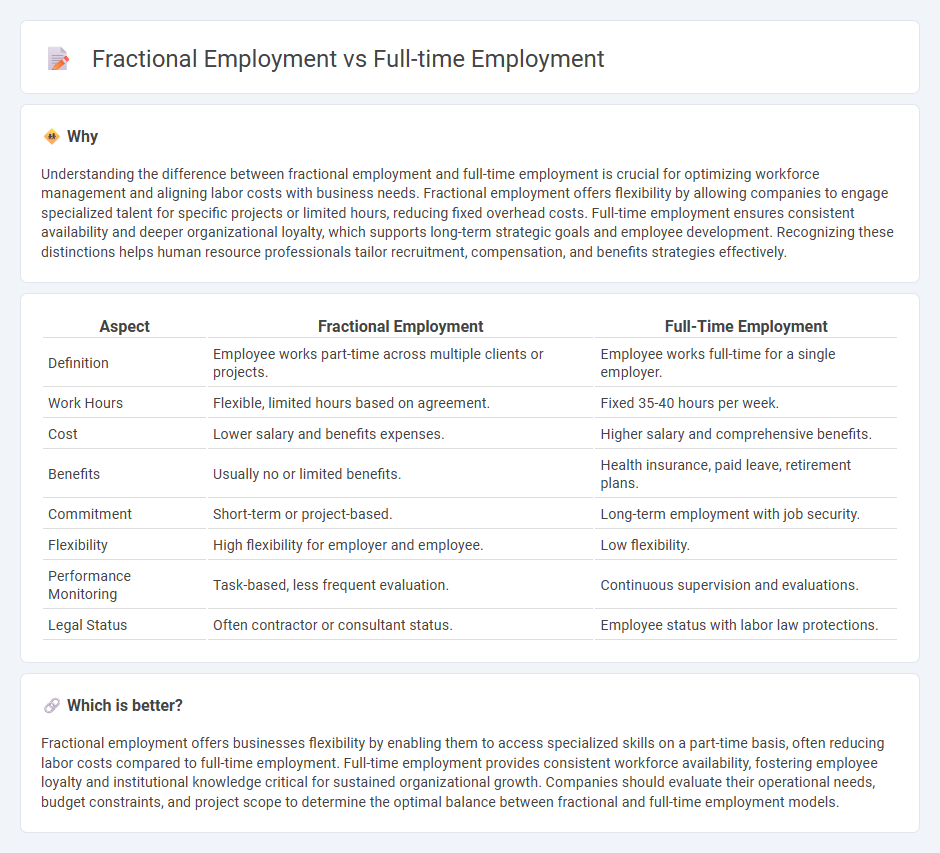
Fractional employment offers organizations flexible access to specialized talent on a part-time basis, reducing overhead costs compared to full-time employment which involves dedicated staff with comprehensive benefits and long-term commitments. Companies leverage fractional roles to swiftly address skill gaps and scale teams without the constraints of permanent hiring. Explore the advantages and challenges of both hiring models to optimize your workforce strategy.
Why it is important
Understanding the difference between fractional employment and full-time employment is crucial for optimizing workforce management and aligning labor costs with business needs. Fractional employment offers flexibility by allowing companies to engage specialized talent for specific projects or limited hours, reducing fixed overhead costs. Full-time employment ensures consistent availability and deeper organizational loyalty, which supports long-term strategic goals and employee development. Recognizing these distinctions helps human resource professionals tailor recruitment, compensation, and benefits strategies effectively.
Comparison Table
| Aspect | Fractional Employment | Full-Time Employment |
|---|---|---|
| Definition | Employee works part-time across multiple clients or projects. | Employee works full-time for a single employer. |
| Work Hours | Flexible, limited hours based on agreement. | Fixed 35-40 hours per week. |
| Cost | Lower salary and benefits expenses. | Higher salary and comprehensive benefits. |
| Benefits | Usually no or limited benefits. | Health insurance, paid leave, retirement plans. |
| Commitment | Short-term or project-based. | Long-term employment with job security. |
| Flexibility | High flexibility for employer and employee. | Low flexibility. |
| Performance Monitoring | Task-based, less frequent evaluation. | Continuous supervision and evaluations. |
| Legal Status | Often contractor or consultant status. | Employee status with labor law protections. |
Which is better?
Fractional employment offers businesses flexibility by enabling them to access specialized skills on a part-time basis, often reducing labor costs compared to full-time employment. Full-time employment provides consistent workforce availability, fostering employee loyalty and institutional knowledge critical for sustained organizational growth. Companies should evaluate their operational needs, budget constraints, and project scope to determine the optimal balance between fractional and full-time employment models.
Connection
Fractional employment and full-time employment are connected through their shared goal of fulfilling organizational workforce needs with varying levels of commitment and flexibility. Fractional employment allows companies to access specialized skills on a part-time or project basis, complementing full-time employees who maintain continuous operational roles. This hybrid approach enhances talent management by balancing cost efficiency with sustained productivity in human resources.
Key Terms
Work Hours
Full-time employment typically requires employees to work 35 to 40 hours per week, ensuring consistent availability and engagement with company tasks. Fractional employment divides work hours among multiple employers, allowing professionals to allocate limited hours, usually less than 20 per week, to each role based on specific project needs. Explore how these work hour structures impact productivity and job flexibility in various industries.
Benefits Eligibility
Full-time employment typically offers comprehensive benefits eligibility, including health insurance, retirement plans, paid time off, and employee wellness programs, ensuring financial and health security for workers. Fractional employment often provides limited or no access to these benefits, focusing on flexibility and cost savings instead, which may affect long-term employee satisfaction and retention. Explore the full scope of benefits eligibility differences to decide which employment structure aligns best with your business needs.
Compensation Structure
Full-time employment typically offers a fixed salary with additional benefits such as health insurance, retirement plans, and paid leave, creating a stable and predictable compensation structure. Fractional employment, on the other hand, usually involves hourly or project-based payments without the extra benefits, allowing for flexible earnings aligned with specific tasks or time commitments. Explore further to understand which compensation model suits your business needs best.
Source and External Links
Full-time employment | EBSCO Research Starters - Full-time employment typically means working a minimum of 30 hours per week, with many employers offering higher wages and benefits compared to part-time employees; the Affordable Care Act specifically defines full-time as 30 or more hours per week or 130 hours per month, though employers can set their own standards otherwise.
Full-time job - Wikipedia - A full-time job is employment where workers work a minimum number of hours defined by their employer, often about 40 hours per week, and "full-time" can also refer to students enrolled in a full course load depending on country-specific definitions.
Job Comparison: Full-Time vs. Part-Time - Under the Affordable Care Act, a full-time employee works at least 30 hours per week or 130 hours per month, and employers with 50 or more full-time equivalents must provide health insurance benefits, with the definition of full-time usually set by the employer but influenced by federal laws.
 dowidth.com
dowidth.com